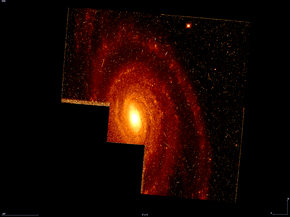NGC 4939
| NGC 4939 | |
|---|---|
 NGC 4939 by Hubble Space Telescope | |
| Observation data (J2000 epoch) | |
| Constellation | Virgo |
| Right ascension | 13h 04m 14.4s[1] |
| Declination | −10° 20′ 22″[1] |
| Redshift | 0.010374 ± 0.000013 [1] |
| Heliocentric radial velocity | 3,110 ± 4 km/s[1] |
| Distance | 118 ± 30 Mly (36.1 ± 9.4 Mpc)[1] |
| Apparent magnitude (V) | 11.3[2] |
| Characteristics | |
| Type | SA(s)bc [1] |
| Apparent size (V) | 5′.5 × 2′.8[1] |
| Notable features | Seyfert galaxy |
| Other designations | |
| MCG -02-33-104, PGC 45170[1] | |
NGC 4939 is a spiral galaxy located in the constellation Virgo. It is located at a distance of circa 120 million light years from Earth, which, given its apparent dimensions, means that NGC 4939 is about 190,000 light years across. It was discovered by William Herschel on March 25, 1786.[3]
Characteristics
NGC 4939 has been characterised as a Seyfert galaxy, a galaxy category which features bright point-like nuclei. NGC 4939 is a type II Seyfert galaxy. Its X ray spectrum is more consistent with a Compton-thick cold reflection source, which means that the source is hidden behind dense material, mainly gas and dust, and the X-ray observed have been reflected, but a Compton-thin transmission model could not be ruled out.[4] The equivalent width of the FeKα line is large, indicating too that it is a Compton-thick source.[5] Further observations by Swift Observatory confirmed its Compton-thick nature.[6] The source of activity in the active galactic nuclei is a supermassive black hole (SMBH) lying at the centre of the galaxy. The SMBH at the centre of NGC 4939 is accreting material with a rate of 0.077 M☉ per year.[7] The black hole has been detected in hard X-rays, which are not absorbed by the Compton-thick column, by INTEGRAL.[8]
The galaxy has a large elliptical bulge and maybe a weak bar. It is a grand design spiral galaxy, with two tightly wrapped arms emanating from the bulge. The arms are thin, smooth and well defined and can be traced for nearly one and a half revolutions before fading.[9] Two symmetric arm sections or arcs are observed in the central part of the galaxy.[10] The galaxy is seen with an inclination of 56 degrees. The rotational speed of the galaxy is about 270 km/s.[11]
Supernovae
NGC 4939 has been home of four supernovae in the last 50 years; SN 1968X (mag 16.0), SN 1973J (mag 16), SN 2008aw (Type II, mag 15.9), and SN 2014B (Type IIP, mag 17.0).[12][13]
Nearby galaxies
NGC 4939 belongs to a small galaxy group known as the NGC 4933 group, named after the multiple galaxy NGC 4933.[14]
References
- ^ a b c d e f g h "NASA/IPAC Extragalactic Database". Results for NGC 4939. Retrieved 2016-01-18.
- ^ "Revised NGC Data for NGC 4939". spider.seds.org. Retrieved 25 November 2018.
- ^ Seligman, Courtney. "NGC 4939 (= PGC 45170)". Celestial Atlas. Retrieved 19 November 2018.
- ^ Maiolino, R.; Salvati, M.; Bassani, L.; Dadina, M.; della Ceca, R.; Matt, G.; Risaliti, G.; Zamorani, G. (October 1998). "Heavy obscuration in X-ray weak AGNs". Astronomy and Astrophysics. 338: 781–794. arXiv:astro-ph/9806055. Bibcode:1998A&A...338..781M.
- ^ Dadina, M. (4 October 2006). "BeppoSAX observations in the 2–100 keV band of the nearby Seyfert galaxies: an atlas of spectra". Astronomy & Astrophysics. 461 (3): 1209–1252. doi:10.1051/0004-6361:20065734.
- ^ Vasudevan, Ranjan V.; Brandt, William N.; Mushotzky, Richard F.; Winter, Lisa M.; Baumgartner, Wayne H.; Shimizu, Thomas T.; Schneider, Donald. P.; Nousek, John (15 January 2013). "X-ray properties of the northern galactic cap sources in the 58 month Swift/BAT catalog". The Astrophysical Journal. 763 (2): 111. arXiv:1212.2957. Bibcode:2013ApJ...763..111V. doi:10.1088/0004-637X/763/2/111.
- ^ Diamond-Stanic, Aleksandar M.; Rieke, George H. (20 February 2012). "The relationship between black hole growth and star formation in Seyfert galaxies". The Astrophysical Journal. 746 (2): 168. arXiv:1106.3565. Bibcode:2012ApJ...746..168D. doi:10.1088/0004-637X/746/2/168.
- ^ "IGR J13042-1020: a massive black hole in spiral galaxy NGC 4939". sci.esa.int. ESA. 11 June 2010.
- ^ Eskridge, Paul B.; Frogel, Jay A.; Pogge, Richard W.; Quillen, Alice C.; Berlind, Andreas A.; Davies, Roger L.; DePoy, D. L.; Gilbert, Karoline M.; Houdashelt, Mark L.; Kuchinski, Leslie E.; Ramirez, Solange V.; Sellgren, K.; Stutz, Amelia; Terndrup, Donald M.; Tiede, Glenn P. (November 2002). "Near‐Infrared and Optical Morphology of Spiral Galaxies". The Astrophysical Journal Supplement Series. 143 (1): 73–111. arXiv:astro-ph/0206320. Bibcode:2002ApJS..143...73E. doi:10.1086/342340.
- ^ Grosbøl, P.; Patsis, P. A.; Pompei, E. (12 August 2004). "Spiral galaxies observed in the near-infrared K band". Astronomy & Astrophysics. 423 (3): 849–859. doi:10.1051/0004-6361:20035804.
- ^ Mitchell, Carl J.; Sellwood, J. A.; Williams, T. B.; Spekkens, Kristine; Kuzio de Naray, Rachel; Bixel, Alex (23 February 2018). "The RINGS Survey. III. Medium-resolution H-alpha Fabry–Pérot Kinematic Data Set". The Astronomical Journal. 155 (3): 123. arXiv:1801.07750. doi:10.3847/1538-3881/aaabb8.
{{cite journal}}: CS1 maint: unflagged free DOI (link) - ^ List of Supernovae IAU Central Bureau for Astronomical Telegrams. Retrieved 29 December 2015.
- ^ "Bright Supernova pages - Most prolific galaxies". www.rochesterastronomy.org.
- ^ Makarov, Dmitry; Karachentsev, Igor (21 April 2011). "Galaxy groups and clouds in the local (z∼ 0.01) Universe". Monthly Notices of the Royal Astronomical Society. 412 (4): 2498–2520. arXiv:1011.6277. Bibcode:2011MNRAS.412.2498M. doi:10.1111/j.1365-2966.2010.18071.x.
{{cite journal}}: CS1 maint: unflagged free DOI (link)
External links
- NGC 4939 on WikiSky: DSS2, SDSS, GALEX, IRAS, Hydrogen α, X-Ray, Astrophoto, Sky Map, Articles and images
